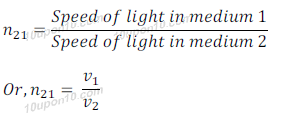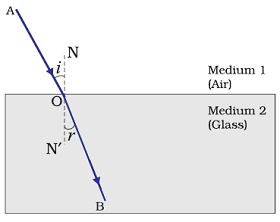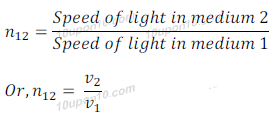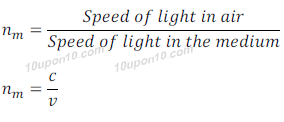Light: Reflection & Refraction - Class 10th Science
Refraction of Light
Phenomenon of bending of ray of light towards normal while entering from rarer medium to denser medium and vice versa is called the Refraction of Light.
When light enters from rare medium, say air to a denser medium say water, it bends towards normal and when enters from denser medium to rarer medium, say from water to air, it goes away from normal. This phenomenon is called The Refraction of Light.
Example:
When a pencil is put in a glass full of water, pencil appears bent. This happens because of refraction of light.
When a coin is kept in a tub filled with water, it appears slightly above the bottom.
Laws of Refraction of Light
(i) The incident ray, the refracted ray and the normal to the interface of two transparent media at the point of incidence, all lie in the same plane.
(ii) The ratio of sine of the angle of incidence to the sine of angle of refraction is a constant, for the light of a given colour and for the given pair of media.
This law is known as Snell's Law of Refraction of Laws of Refraction of light.
If angle of incidence is 'i' and angle of refraction is 'r', then according to the Laws of Refraction of Light

The constant value is called the Refractive Index of the second medium with reference to the first.
Refractive Index
Refractive Index is the extent of change in direction of light while travelling from one medium to another medium.
In other words, ratio of the angle of sine of incidence to the angle of sine refraction for the given pair of media is called the Refractive Index.
Refractive Index and speed of Light
Value of Refractive index is related to the relative speed of light in different media. Light travels with different speed in different media. The speed of light is 3 x 108 m s– in vacuum which is fastest and slightly less than in air.
Speed of light decreases with denser media.
Refractive Index of Light in one medium with respect to other
Let light enters from medium 1 to medium 2.
Let, v1 is the speed of light in medium 1
Let, v2 is the speed of light in medium 2
∴ The refractive index of medium 2 with respect to medium 1 is given by the ratio of the speed of light in medium 1 and the speed of light in medium 2.
This is generally represented by the symbol n2 1


Refractive Index of medium 1 with respect to medium 2
Let light enters from medium 2 to medium 1.
Let, v1 is the speed of light in medium 1
Let, v2 is the speed of light in medium 2
∴ The refractive index of medium 1 with respect to medium 2 is given by the ratio of the speed of light in medium 2 and the speed of light in medium 1.
This is generally represented by the symbol n1 2

Refractive Index when one of the medium is vacuum
The value of Refractive index of a medium with respect of vacuum is called ABSOLUTE REFRACTIVE INDEX.
In other words, Absolute Refractive Index is the refractive index of a medium with respect of vacuum.
Example, let if medium 1 is vacuum and medium 2 is any other medium
Therefore,
Absolute Refractive Index of the given medium (nm)

The absolute refractive index of a medium is simply called its Refractive Index.
For example Refractive index of air (na) is 1.0003, Refractive Index of Ice (ni) is 1.31, Refractive index of Water (nw) is 1.33, etc.
Optical Density
The ability of a medium to refract light is also expressed in terms of its OPTICAL DENSITY. Optical density is not the same as mass density.
Denser medium means Optically denser medium and Rarer medium means Optically rarer medium.
Optically Denser Medium:
Medium which has greater or larger Refractive Index is called optically denser medium.
Optically Rarer Medium:
Medium which has lesser or smaller Refractive Index is called optically rarer medium. For Example: Refractive Index of Kerosene oil is 1.44 and Refractive Index of ice is 1.31. Therefore in the comparison of Ice and kerosene oil, Ice is optically rarer medium while kerosene oil is optically denser medium.
Speed of Light in different Medium:
Speed of light is fastest in vacuum. Speed of light decreases with increase in refractive index and increases with decrease in refractive index. This means speed of light is greater in rarer medium while lesser in denser medium.
Example: Refractive Index of crown glass is 1.52 while of Fused quartz is 1.46. This means crown glass is denser medium than fused quartz. Thus, speed of light is greater in fused quartz than that of crown glass.
Since speed of light decreases in denser medium, because of this when light enter from a rarer medium to denser medium, it bends towards normal and when light enters from denser medium to rarer medium light bends away from normal.
Thus, it is the speed of light in different medium which causes Refraction of Light.
Lens
A transparent material bound by two surfaces of which one or both surfaces are spherical, is called lens.
Types of Lens:
Convex Lens
A lens having two spherical surface bulging outwards is called Convex Lens. A convex lens is called double convex lens also.
A convex lens is thicker at the middle as compared to the edges.
A convex lens converges rays of light pass through it, so a convex lens is known as CONVERGING LENS also.
Concave Lens
A lens having two spherical surface curved inwards is called Concave Lens. A concave lens is thicker at edges than at the middle.
A concave lens diverges rays of light, hence a concave lens is called DIVERGING LENS also.
Important terms of Spherical Lens
Centre of Curvature: A spherical lens is formed by the parts of the combination of two spherical surfaces. The centres of these spheres are called the centre of curvature of the lens.
There are two centre of curvature of a lens on either side.
Generally centre of curvature of a lens is represented by C1 and C2 respectively.
Optical Centre: The central point of a lens is called its optical centre. The optical centre of a lens is generally denoted by letter 'O'.
Principal axis: An imaginary line passing through the centre of curvatures of al lens is called Principal Axis.
Principal Focus: Point at which rays coming parallel to the principal axis converge is called the Principal Focus of a convex lens.
In the case of Concave lens, point at which rays coming parallel to the principal axis appear to be diverged is called Principal Focus of a Concave lens.
There are two principal focus, which lie either side of a spherical lens. These principal focus are generally represented by F1 and F2.
Focal Length: Distance between Principal focus (F) and optical centre (O) of a spherical lens is called Focal Length of a spherical lens. Focal length is represented by letter 'f'.
Focal length is equal to half of the centre of curvature, i.e. C1 = 2F1